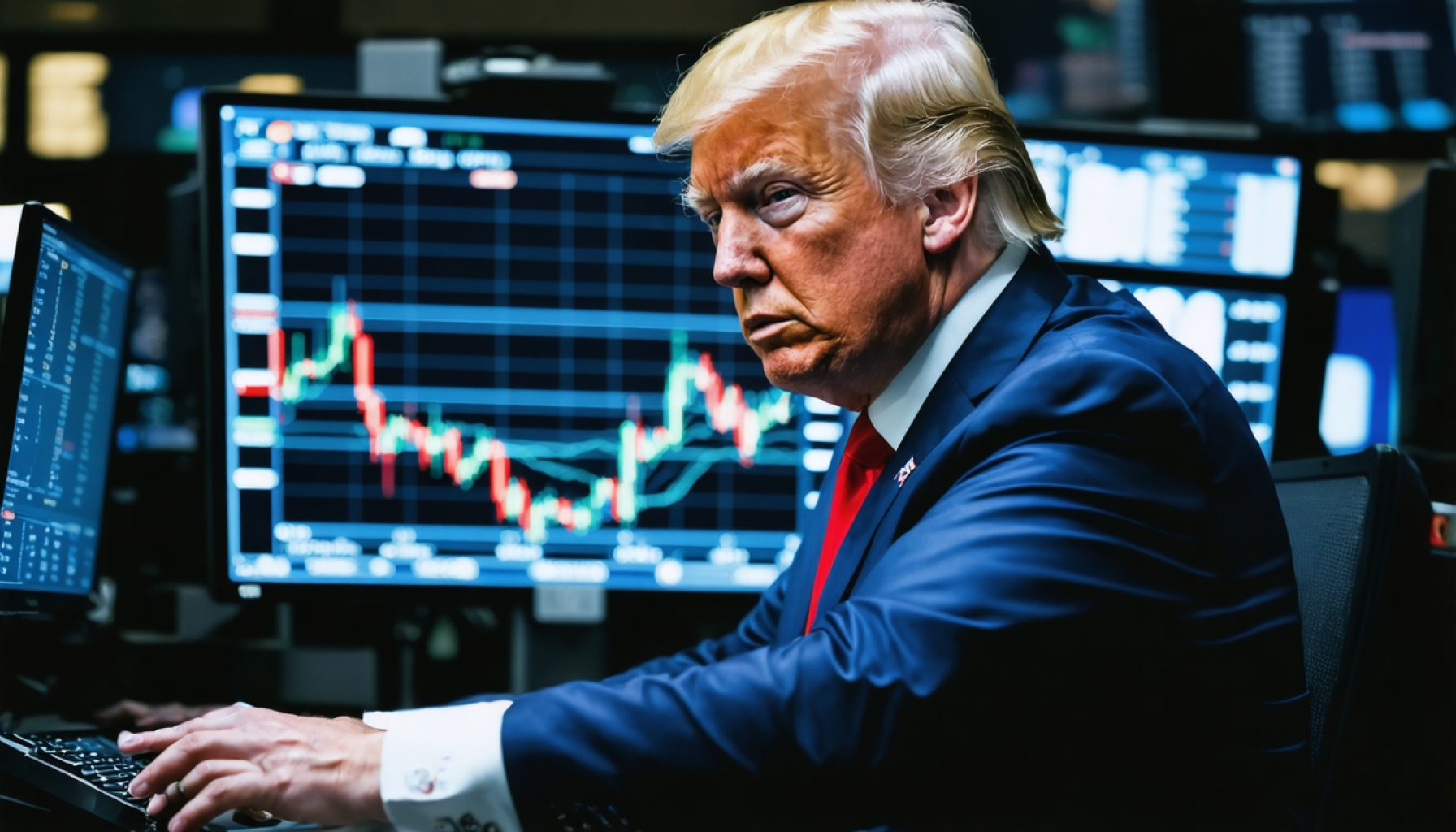- President Trump announced new tariffs targeting countries with trade surpluses, causing market volatility and mixed reactions.
- The announcement quickly spread online, with a viral video juxtaposing the speech with live stock ticker updates.
- Despite a brief uptick, stock futures for the S&P 500 and Nasdaq fell sharply, signaling market uncertainty.
- The event highlighted the complex and fragile nature of global markets, emphasizing how policy decisions can have widespread economic impacts.
- Investors are closely watching developments, aware of potential long-term implications of tariff strategies.
- This incident underscores the interconnectedness of global economies and the significant role of social media in shaping financial narratives.
A whirlwind ripped through the financial world as President Donald Trump took to the podium at the White House, his words sending ripples across the stock market. It was a clear afternoon when the announcement came—the United States would impose sweeping new tariffs on numerous countries with trade surpluses. This decision, intended as a bold economic strategy, stirred both applause and anxiety among economists and traders alike.
As Trump laid out his plan, a moment captured on video rapidly spread online, accumulating nearly half a million views within hours. The clip, shared by a prominent account on X, formerly known as Twitter, juxtaposed the President’s speech with a live ticker of stock performances. CNBC’s real-time coverage echoed the growing apprehension; a visual representation of markets bracing for impact.
Though the S&P 500 showed a steady climb by the end of Wednesday’s regular trading—up by 0.7%, while the Dow Jones and Nasdaq rose by 0.6% and 0.9%, respectively—the mood was anything but stable. As night fell and trading moved into futures, the optimism evaporated. The figures told a story of looming uncertainty: S&P 500 futures plunged 3.6%, while the Nasdaq futures, often sensitive to tech sector woes, plummeted by 4.5%.
The scene was set for a volatile Thursday. Investors, both seasoned and novice, watched closely, aware of the volatile nature of geopolitical and economic shifts. What lay beneath the numbers was a deeper narrative—a testament to how interconnected our world economy truly is. Tariffs, while a tool for negotiation and balance, also hold the power to unseat financial stability, leaving businesses and market analysts scrambling to predict the long-term implications.
This incident serves as a poignant reminder of the fragility and complexity of global markets. The impact of policies like tariffs extends beyond immediate headlines or viral videos; it shapes economic landscapes for years to come. As businesses and investors adjust to this new reality, the effects of such political decisions will be dissected, debated, and doubted, much like the viral video that captured a singular moment with lasting repercussions.
In the tapestry of today’s interconnected market, few events stand alone. Each ripple, a potential wave. As history unfolds in real-time via social media, one thing becomes evident: The world is watching, alert and apprehensive, ready to navigate the uncharted waters of economic change.
How President Trump’s Tariff Announcement Shook Global Markets: An In-Depth Analysis
The Global Impact of Tariffs and Financial Market Volatility
President Donald Trump’s announcement of new tariffs on countries with trade surpluses served as a stark reminder of the intricate relationship between political decisions and financial market stability. This decision not only affected the U.S. stock market but also had far-reaching implications across global economies.
Key Insights and Implications
1. Economic Context: The imposition of tariffs is often a double-edged sword. On one hand, it aims to protect domestic industries by discouraging imports, thereby supporting local jobs and reducing trade deficits. On the other, it can lead to retaliation from other countries, increasing import costs and ultimately affecting consumers and businesses.
2. Market Reactions: While the S&P 500, Dow Jones, and Nasdaq showed initial gains post-announcement, futures trading highlighted the uncertainty and fear that tariffs incite among investors. A drop in futures suggests a lack of confidence in sustained growth and a potential reevaluation of market stock values, especially in technology sectors.
3. Investor Strategies: Experienced investors often hedge against such volatility by diversifying portfolios, involving assets like bonds, international stocks, or commodities. Additionally, some might turn to options trading to offset potential losses or take advantage of fluctuating prices.
4. Historical Precedents: The effects of tariffs can be traced back to historical events, such as the Smoot-Hawley Tariff during the Great Depression, which contributed to a significant decline in international trade. Modern examples like the U.S.-China trade war illustrate similar economic strain and market unpredictability.
5. Future Trends and Predictions: Experts anticipate increased market volatility in sectors reliant on international trade, such as technology and automotive industries. In the longer term, persistent trade tensions could spur supply chain reconfiguration and adversely affect global economic growth rates.
Pressing Questions Answered
– Why do tariffs cause market volatility? Tariffs increase the cost of imported goods, disrupt supply chains, and can lead to trade wars. This uncertainty leads to fluctuating investor confidence and stock price volatility.
– How do tariffs affect consumers? Increased tariffs typically result in higher prices for consumer goods. Companies often pass these costs onto consumers, reducing disposable income and potentially leading to decreased consumer spending.
Conclusion and Recommendations
Given the unpredictability introduced by tariff announcements, investors and businesses need to adopt proactive strategies. Here are actionable recommendations:
– Diversify Investments: Reduce dependency on sectors vulnerable to tariff fluctuations, such as technology or automotive sectors, by diversifying into different asset classes.
– Stay Informed: Regularly monitor government policy announcements and economic indicators to anticipate market shifts.
– Consider Hedging: Use financial instruments like options or futures to protect against potential losses.
Understanding the broader economic implications of political decisions, such as tariffs, is crucial in maintaining financial health. By staying informed and flexible, investors and businesses can better navigate these turbulent economic waters.
For more insights into financial markets and economic trends, visit CNBC and Bloomberg.
